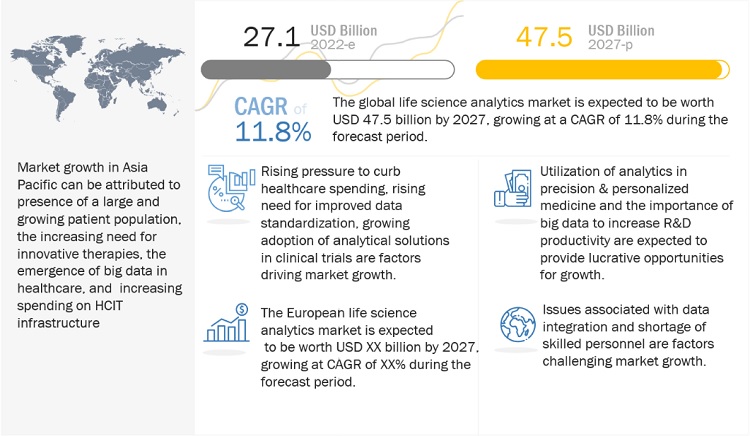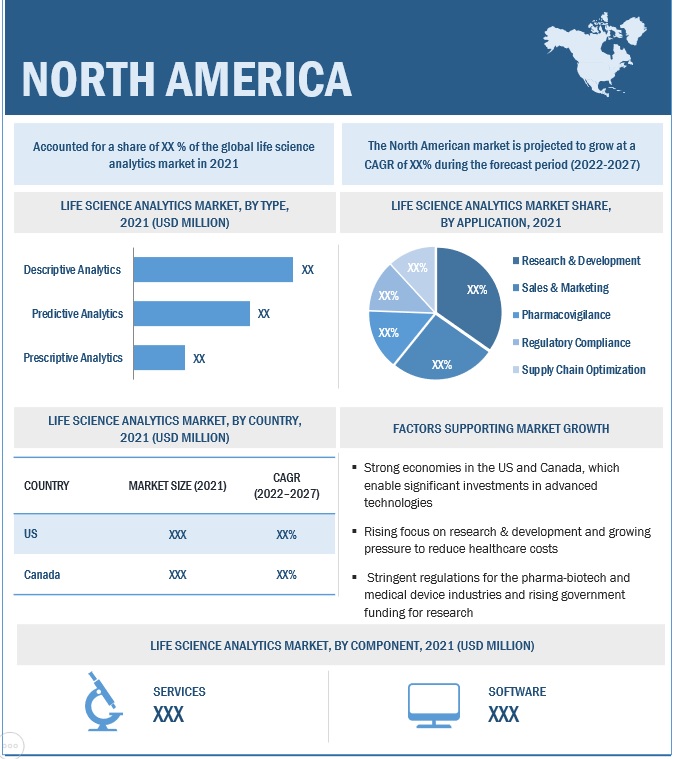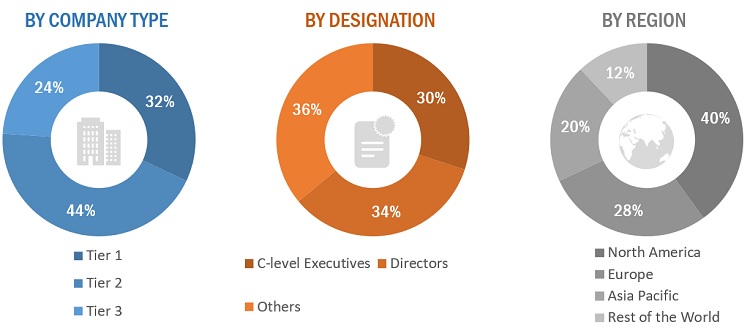Life Science Analytics Market by Type (Predictive, Descriptive, Prescriptive), Application (Sales & Marketing, Regulatory Compliance, R&D, Pharmacovigilance), Component (Software, Service), Delivery (On Premise, On Demand), End User & Region - Global Forecast to 2027
The global life science analytics market in terms of revenue was estimated to be worth $27.1 billion in 2022 and is poised to reach $47.5 billion by 2027, growing at a CAGR of 11.8% from 2022 to 2027. The new research study consists of an industry trend analysis of the market. The new research study consists of industry trends (life science industry trends), pricing analysis, patent analysis, conference and webinar materials, key stakeholders, and buying behaviour in the market. Growth in this market is mainly driven by the increasing adoption of analytics for sales and marketing applications, the rising prevalence of chronic diseases, and the growing pressure to curb healthcare spending. However, high implementation costs of analytical solutions and patient data privacy concerns are expected to restrain the growth of this market.
Attractive Opportunities in the Life Science Analytics Market

To know about the assumptions considered for the study, Request for Free Sample Report
Life Science Analytics Market Dynamics
Driver: Rising pressure to curb healthcare spending
Globally, the cost of healthcare is on the rise due to the growing demand for healthcare services, increasing prices of medical services, development of expensive prescription drugs and medical technologies, unhealthy lifestyles, rapid growth in the geriatric population, rising prevalence of chronic diseases, and lack of transparency of information on prices and quality. Moreover, operational inefficiencies, hospital readmissions, medical errors, and adverse drug events increase healthcare costs. The need to curb growing healthcare costs is one of the key growth drivers for the global market.
Restraint: High implementation costs of advanced analytical solutions
Despite the known benefits of analytics in the life science industry, the high implementation and subscription/licensing fees for advanced analytics solutions is a major limitation owing to budgetary concerns faced by many pharmaceutical companies and other stakeholders. Only top-tier companies have the capability and funding to utilize big data to provide actionable insights effectively. According to industry experts, the cost of these solutions ranges from USD 10,000 to several million, depending on factors such as application areas, type of analytics solutions, product features, delivery model, and amount of data. High price make these solutions less reasonable for small- and medium-sized pharmaceutical and biotechnology companies and CROs with restricted budgets, thereby restricting their adoption. This trend is particularly obvious in emerging economies, where it is always hard to obtain budgets for IT over medical equipment.
Opportunity: Big data analytics for R&D productivity
The life science industry is experiencing various challenges, such as patent expirations, push for generics, increasing costs, lower margins, increasing stringency of FDA regulations, and lower R&D productivity. However, the impact of many of these challenges can be offset/reduced by using advanced technologies, such as analytics. Analytics solutions can process data from multiple sources, such as millions of documents, protocols, study records, images, and applications, to provide a unified view. A potential benefit of big data analytics is to find potential patients to enroll in clinical trials based on social media profiles, genetic information, and information collected in electronic health records and not just on the evaluation of physicians. Companies can also use smart devices to gather large quantities of real-world data that were not available for R&D teams in the past.
Challenge: Shortage of skilled personnel
Globally, there are only a limited number of organizations with sufficient in-house experts to translate large volumes of data into valuable insights. According to Randstad Sourceright’s 2022 Talent Trends report, 33% of C-suite and human capital leaders in the life sciences & pharmaceuticals sector reported that talent scarcity is one of the major factors for the life science sector. According to the Economic Survey 2021, India’s domestic pharmaceutical market is expected to reach USD 65 Billion by 2024. There is still a shortage of skilled professionals in the pharmaceutical industry. The shortage of skilled professionals to handle life science analytics solutions is a major factor restraining the market growth.
The descriptive analytics segment accounted for the largest share of the life science analytics industry in 2021, by type.
On the basis of type, the life science analytics market is bifurcated into descriptive, predictive, and prescriptive analytics. In 2021,the descriptive analytics segment accounted for the largest market share. The large share of this segment is primarily attributed due to the emergence of COVID-19 to understand the disease prognosis and treatment procedure required for the virus.
The sales and marketing segment is expected to grow at the highest CAGR in the life science analytics industry during the forecast period.
On the basis of application, the life science analytics market is bifurcated into research & development (clinical trials and preclinical trials), sales & marketing, regulatory compliance, supply chain optimization, and pharmacovigilance. During the forecast period,the sales & marketing segment is expected to grow at the highest CAGR.The high growth of this segment is attributed to the growing adoption of analytics for sales & marketing activities and increasing significance of post-marketing surveillance.
The pharmaceutical and biotechnology companies segment accounted for the largest share of the life science analytics industry in 2021, by end user.
On the basis of end user, the life science analytics market is bifurcated into pharmaceutical & biotechnology companies, medical device companies, research centers, and third-party administrators (TPAs). In 2021, the pharmaceutical & biotechnology companies segment hold the largest share of the global market.This can be attributed to the increasing use of analytics and rising growth in pharmaceutical industries worldwide.
North America to dominate the life science analytics industry in 2021
On the basis of region, the life science analytics market is bifurcated into North America, Europe, Asia, and the Rest of the World (RoW). In 2021, North America dominated the global market, followed by Europe. However, Asia Pacific is expected to grow at the highest CAGR during the forecast period owing to the increasing adoption of advanced technologies and the growing focus of major players on expanding their presence in emerging Asia Pacific countries.

To know about the assumptions considered for the study, download the pdf brochure
Prominent players in the life science analytics market include Oracle (US), IBM (US), SAS Institute Inc. (US), Accenture (Ireland), IQVIA Inc (US), Cognizant< (US), Wipro (India), Allscripts Healthcare, LLC (US), Optum, Inc. (US), Microsoft (US), MaxisIT (US), ExlService Holdings, Inc. (US), Cerner Corporation (US), Cotiviti, Inc. (US), Inovalon (US), CitiusTech Inc (US), Saama Technologies, LLC. (US), Axtria (US), Clarivate (UK), ThoughtSphere (US), ThoughtSpot Inc. (US), Alteryx, Inc. (US), Sisense Inc. (US), Amazon Web Services, Inc., and Veeva Systems (US).
Scope of the Life Science Analytics Industry
|
Report Metric |
Details |
|
Market Revenue in 2022 |
$27.1 billion |
|
Projected Revenue by 2027 |
$47.5 billion |
|
Revenue Rate |
Poised to Grow at a CAGR of 11.8% |
|
Market Driver |
Rising pressure to curb healthcare spending |
|
Market Opportunity |
Big data analytics for R&D productivity |
The research report categorizes the life science analytics market to forecast revenue and analyze trends (life science industry trends) in each of the following submarkets:
By Type
- Descriptive Analytics
- Predictive Analytics
- Prescriptive Analytics
By Component
- Services
- Software
By Delivery Model
- On-premise model
- On-demand model
By Application
- Research & Development
- Preclinical Trials
- Clinical Trials
- Sales & Marketing
- Regulatory Compliance
- Supply Chain Optimization
- Pharmacovigilance
By End User
- Pharmaceutical & Biotechnology Companies
- Medical Device Companies
- Research Centers
- Third-party Administrators
By Region
-
North America
- US
- Canada
-
Europe
- Germany
- France
- UK
- Italy
- Rest of Europe (RoE)
-
Asia Pacific
- Japan
- China
- India
- Rest of Asia Pacific (RoAPAC)
- Rest of the World (RoW)
Recent Developments of Life Science Analytics Industry
- In November 2022, IQVIA (US) collaborated with Clalit (Israel) to launch the first Prime Site in the country. The collaboration will allow focus on the future of innovation, including precision medicine and the delivery of data-driven trials.
- In June 2022, SAS Institute Inc. (US) entered into an agreement with Gunvatta (US) to expedite clinical trials and FDA reporting through the SAS Life Science Analytics Framework on Azure.
- In March 2022, Wipro Limited (India) partnered with Pandorum (India). This partnership will provide insights into the potential outcomes of specific formulations, apply advanced algorithms to predict and enhance the efficiency of therapeutics, and improve clinical study design.
- In January 2021, Oracle (US) collaborated with Cognizant (US) to integrate technologies to reduce study startup time and streamline the management of clinical trials.
- In May 2019, SAS Institute Inc. (US) opened its SAS Cloud offering in an Amazon Web Services Data Center in Singapore.
Frequently Asked Questions (FAQ):
What is the projected market revenue value of the global life science analytics market?
The global life science analytics market boasts a total revenue value of $47.5 billion by 2027.
What is the estimated growth rate (CAGR) of the global life science analytics market?
The global life science analytics market has an estimated compound annual growth rate (CAGR) of 11.8% and a revenue size in the region of $27.1 billion in 2022.
To speak to our analyst for a discussion on the above findings, click Speak to Analyst
The study involved four major activities in estimating the current size of the global life science analytics market. Exhaustive secondary research was done to collect information on the market, its peer markets, and its parent market. The next step was to validate these findings, assumptions, and sizing values with industry experts across the value chain through primary research. Both top-down and bottom-up approaches were employed to estimate the complete market size. Thereafter, market breakdown and data triangulation procedures were used to estimate the market size of segments and subsegments.
Secondary Research
Secondary research was mainly used to identify and collect information for the extensive, technical, market-oriented, and commercial study of the market. Secondary sources include directories; databases such as Bloomberg Business, Factiva, and Wall Street Journal; white papers; and annual reports were also used to obtain key information about major players, market classification, and segmentation according to industry trends (life science industry trends), regional/country-level markets, market developments, and technology perspectives.
Primary Research
In-depth interviews were conducted with various primary respondents, including key industry participants, subject-matter experts (SMEs), C-level executives of key market players, and industry consultants, among other experts, to obtain and verify the critical qualitative and quantitative information as well as assess the prospects of the market. Various primary sources from both the supply and demand sides of the market were interviewed to obtain qualitative and quantitative information. The following is a breakdown of primary respondents:

Note: Tiers are defined based on a company’s total revenue. As of 2021, Tier 1 = >USD 5 billion, Tier 2 = USD 500 million to USD 5 billion, and Tier 3 = <USD 500 million.
* Others include sales managers, marketing managers, and product managers
To know about the assumptions considered for the study, download the pdf brochure
Market Size Estimation
Both top-down and bottom-up approaches were used to estimate and validate the total size of the life science analytics market. These methods were also used extensively to estimate the size of various subsegments in the market. The research methodology used to estimate the market size includes the following:
- The key players in the industry and markets have been identified through extensive secondary research
- The revenue generated from the sale of life science analytics solutions and services by leading players has been determined through primary and secondary research
- All percentage shares, splits, and breakdowns have been determined using secondary sources and verified through primary sources
Data Triangulation
After arriving at the overall market size from the market size estimation process, the total market was split into several segments and subsegments. To complete the overall market engineering process and arrive at the exact statistics for all segments and subsegments, data triangulation and market breakdown procedures were employed, wherever applicable. The data was triangulated by studying various factors and trends (life science industry trends) from both the demand and supply sides.
Report Objectives
- To define, describe, and forecast the life science analytics market on the basis of type, component, application, delivery model, end-user, and region
- To provide detailed information regarding the major factors influencing the market growth (drivers, restraints, opportunities, and industry-specific challenges)
- To strategically analyze micromarkets with respect to individual growth trends (life science industry trends), future prospects, and contributions to the overall market
- To analyze the opportunities in the market for stakeholders and provide details of the competitive landscape for market leaders
- To forecast the size of the market segments with respect to four main regions, namely, North America, Europe, Asia, and the Rest of the World (RoW)
- To profile the key players and comprehensively analyze their product portfolios, market positions, and core competencies
- To track and analyze competitive developments such as partnerships, agreements, mergers & acquisitions, expansions, product & service launches/upgrades, and R&D activities in the market
Available Customizations
With the given market data, MarketsandMarkets offers customizations as per the company’s specific needs.
The following customization options are available for this report. sss
Company Information
- Detailed analysis and profiling of additional market players (up to 5)



 Generating Response ...
Generating Response ...







Growth opportunities and latent adjacency in Life Science Analytics Market